Solar tube ovens create the perfect environment for your quinoa with their exceptional heat control and retention capabilities. You'll find that the vacuum-sealed glass tubes maintain stable temperatures between 232-305 W/m², ideal for quinoa's specific cooking needs. The double-walled insulation and compound parabolic reflectors guarantee even heat distribution, while the sealed environment preserves moisture and nutrients in your grains. You can cook unattended, as the oven's design captures sunlight from various angles throughout the day. The versatile cooking options and nutrient preservation features make this eco-friendly method worth exploring for your favorite quinoa dishes.
Perfect Heat Retention Performance
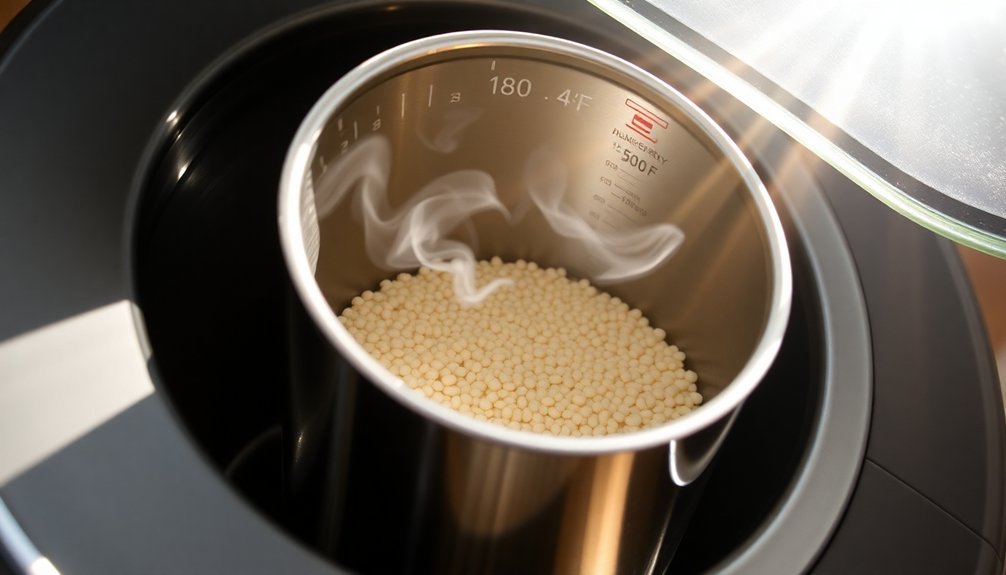
Mastering heat retention stands as the cornerstone of solar tube oven performance, particularly when cooking quinoa.
You'll find that these ovens employ sophisticated double-walled glass tubes with trapped air, creating an exceptional insulation system that keeps your quinoa at the ideal cooking temperature. The air-tight covers prevent thermal loss to the surrounding environment, while the strategic 12mm air gaps in the aperture glazing provide additional insulation benefits.
You'll appreciate how the vacuum-sealed tubes maintain consistent heat even when outdoor temperatures drop. The combination of borosilicate glass tubes and vacuum technology guarantees your quinoa cooks evenly by maintaining stable temperatures between 232 W/m² and 305 W/m². The parabolic folding reflectors maximize solar energy capture for optimal heating performance.
What's more, the incorporation of phase change materials (PCMs) helps maintain prime cooking conditions even during periods of reduced sunlight.
The system's efficient insulation design means you won't need to constantly adjust the oven while cooking. With temperatures reaching up to 250°C and minimal fluctuation, you can count on perfectly cooked quinoa every time.
The double-walled vessels and stainless steel components further enhance this thermal stability, guaranteeing reliable cooking results regardless of external conditions.
Simple Temperature Management Process
Setting up temperature control in solar tube ovens comes down to a few straightforward steps that make cooking quinoa remarkably simple. You'll find the vacuum tube technology, combined with double-walled glass construction, maintains steady temperatures even in varying weather conditions.
The oven's built-in thermometer lets you monitor and adjust cooking temperatures precisely, reaching up to 250°C with stability at ±5°C. You'll notice the outside stays cool while internal temperatures soar, thanks to advanced insulation materials and reflective barriers. Testing shows the system maintains superior thermal efficiency of 38%, significantly outperforming traditional solar ovens.
| Component | Function | Performance |
|---|---|---|
| Vacuum Tubes | Heat Insulation | 40% reduction in fluctuation |
| Metal Coating | Heat Absorption | Multiple layer efficiency |
| Reflectors | Light Collection | Wide-angle capture |
| Thermal Mass | Temperature Stability | Hours of sustained heat |
| Insulation | Heat Retention | Maintains 100°C+ post-peak |
When cooking quinoa, you can rely on the compound parabolic reflectors to capture sunlight from various angles, while the multi-layered metal coating converts both UV and visible light into usable heat. The system's efficiency means you'll achieve consistent results, maintaining cooking temperatures above 100°C even after peak solar hours.
Flexible Cooking Time Options
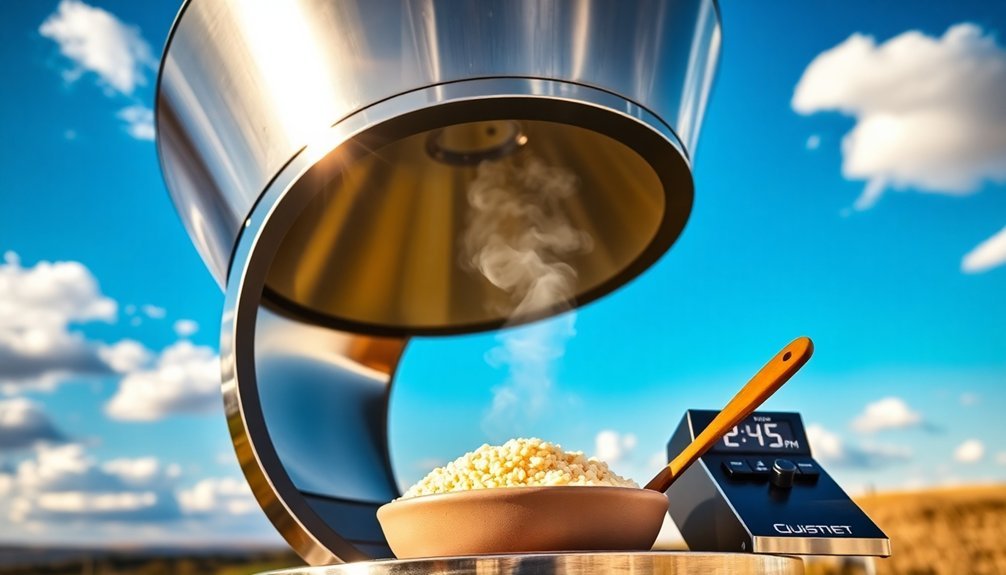
The flexible nature of solar tube ovens gives you multiple timing options for cooking quinoa effectively. You'll find that cooking durations can be adjusted based on sun conditions, with clear sunny days yielding perfectly cooked quinoa in about 45 minutes.
On partially cloudy days, you'll need to extend the cooking time, often doubling what you'd expect from conventional methods. Spreading chopped vegetables evenly in the tray before adding quinoa ensures consistent cooking throughout.
You won't need to constantly monitor your quinoa as it cooks. Unlike parabolic cookers that require repositioning every 15 minutes, solar tube ovens can be positioned ahead of the sun's path for unattended cooking. You can even set up your quinoa to cook while you're away, making it perfect for busy schedules.
Instead of relying solely on timing, you'll get better results using a meat thermometer to confirm when your quinoa is done.
The versatility extends to cooking methods too. You're free to cook quinoa alongside other ingredients, creating complete meals like quinoa pilaf with vegetables.
You can use various liquids such as stock or seasoned water, adapting traditional recipes to work in your solar tube oven while maintaining the dish's nutritional value.
Maximum Nutritional Value Preservation
Through solar tube oven cooking, you'll maximize the nutritional benefits of your quinoa by preserving essential vitamins and minerals. The sealed, insulated environment of a solar tube oven retains moisture and natural juices, guaranteeing your quinoa maintains its nutritional integrity while cooking.
You'll notice that less liquid is needed, which prevents nutrient leaching and helps preserve the grain's protein, fiber, and mineral content. The vacuum tube design considerably reduces oxidation by limiting exposure to oxygen, protecting delicate nutrients that could otherwise be destroyed by conventional cooking methods.
You won't need to worry about nutrient loss through excessive heat exposure, as solar tube ovens operate at gentler temperatures that are ideal for preserving sensitive vitamins and minerals.
When you cook quinoa in a solar tube oven, you're taking advantage of the compound parabolic reflectors and broad spectrum absorbing surfaces that guarantee efficient heat conversion without overheating.
The even heat distribution and moisture retention mean you'll get consistently well-cooked quinoa that retains more of its natural flavors, textures, and nutritional properties than traditional cooking methods provide.
Recipe Adaptability Features
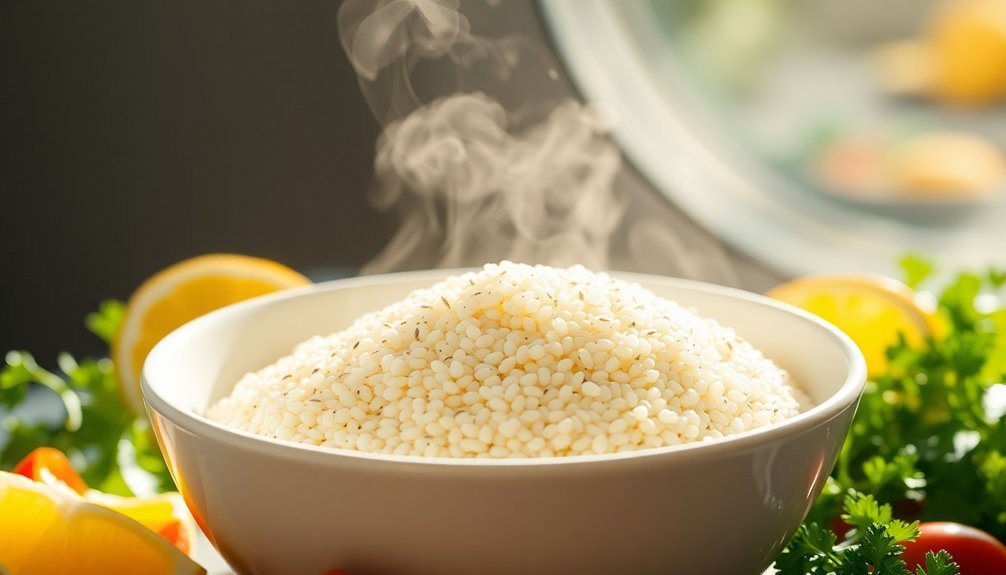
Solar tube ovens offer three key adaptability features that make quinoa recipes highly versatile. You'll find exceptional flexibility in ingredients, with the ability to mix various vegetables, proteins, and seasonings while maintaining consistent cooking results. The hands-off cooking method lets you combine ingredients in a single pot, reducing preparation time and cleanup effort.
You can easily customize your quinoa dishes by incorporating seasonal and regional ingredients, adapting to both local availability and cultural preferences. Whether you're adding black beans for protein, fresh herbs for flavor, or local vegetables for authenticity, your solar-cooked quinoa will maintain its nutritional integrity.
| Adaptability Feature | Benefits |
|---|---|
| Ingredient Flexibility | Mix any vegetables, proteins, and seasonings |
| One-Pot Cooking | Reduced cleanup, simplified preparation |
| Year-Round Usage | Consistent results across seasons |
| Regional Integration | Works with local ingredients and customs |
The oven's consistent temperature control means you don't need to monitor or adjust the cooking process frequently. You're free to prepare accompanying ingredients or focus on other tasks while your quinoa cooks perfectly. This adaptability makes solar tube ovens particularly valuable for both everyday cooking and emergency situations when traditional cooking methods aren't available.
Frequently Asked Questions
Can Solar Tube Ovens Work Effectively on Cloudy or Partially Overcast Days?
Yes, you'll find solar tube ovens work well on cloudy days! Their vacuum-sealed glass tubes retain heat effectively, reaching up to 250°C even with 90% cloud cover, thanks to excellent insulation and heat-holding capabilities.
What's the Average Lifespan of a Solar Tube Oven With Regular Use?
With proper maintenance, your solar tube oven can last 20-30 years or more. You'll find it's nearly unlimited in lifespan since there aren't moving parts, and the durable materials like borosilicate glass resist degradation.
How Do You Clean and Maintain the Evacuated Glass Tubes?
You'll need to clean the tubes with mild soap and warm water, using a soft brush for the interior. Don't use abrasive materials, and always check for cracks or damage during cleaning.
Does Altitude Affect the Cooking Performance of Solar Tube Ovens?
Yes, altitude greatly affects your solar tube oven's performance. You'll get better results at higher elevations due to increased solar radiation, though you'll need proper insulation to counter the cooler ambient temperatures.
Can Solar Tube Ovens Be Used Safely in Windy Conditions?
Yes, you can safely use solar tube ovens in windy conditions. Their stable design, heavy materials, and double-walled insulation protect against wind disruption. You'll still want to use windbreaks for ideal cooking performance.
In Summary
You'll find solar tube ovens are ideal for preparing quinoa thanks to their outstanding heat retention and easy temperature control. They're flexible with cooking times while preserving nutrients better than traditional methods. Whether you're making a basic batch or trying complex recipes, these ovens adapt to your needs. Make the switch to solar tube cooking, and you'll never look back for perfect quinoa every time.

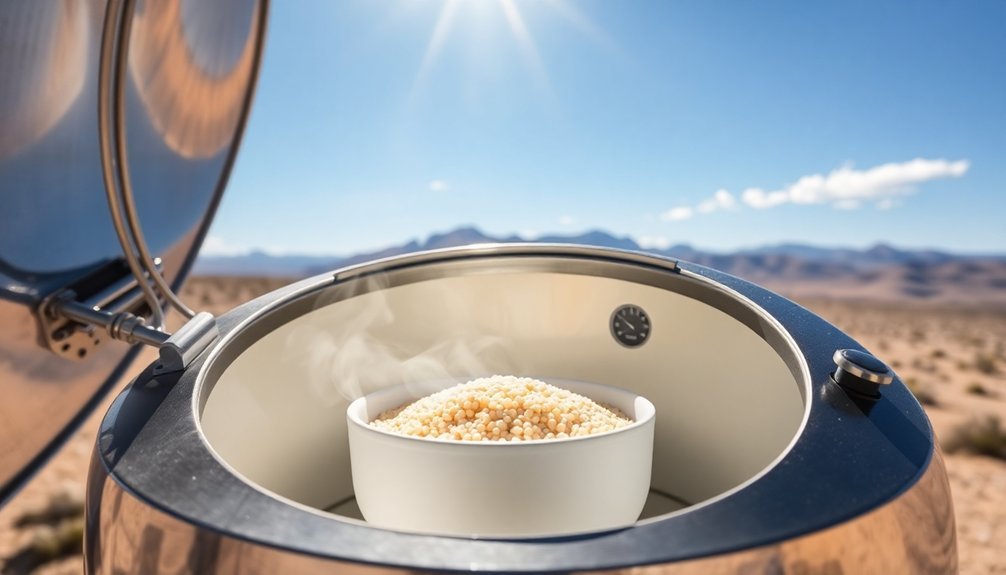
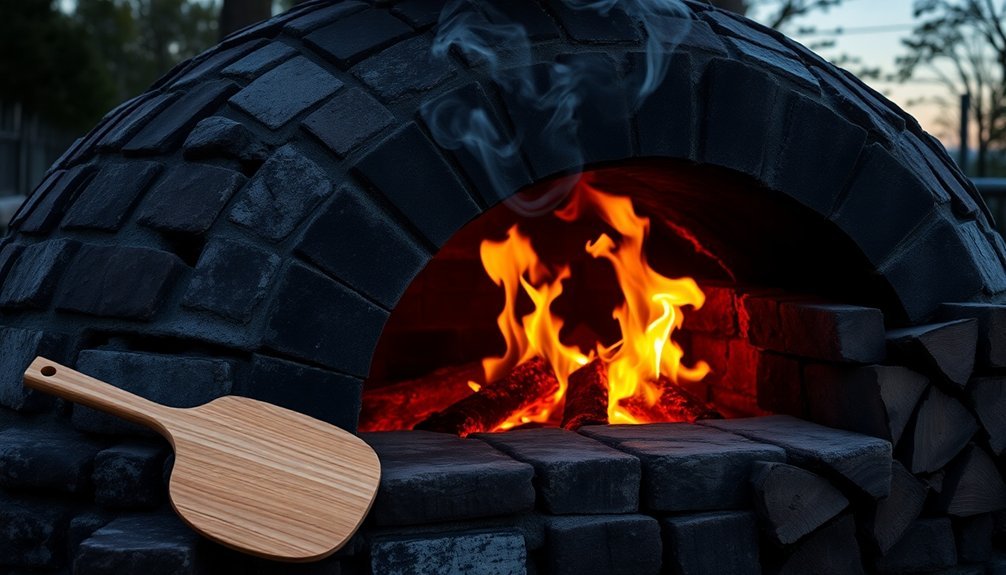
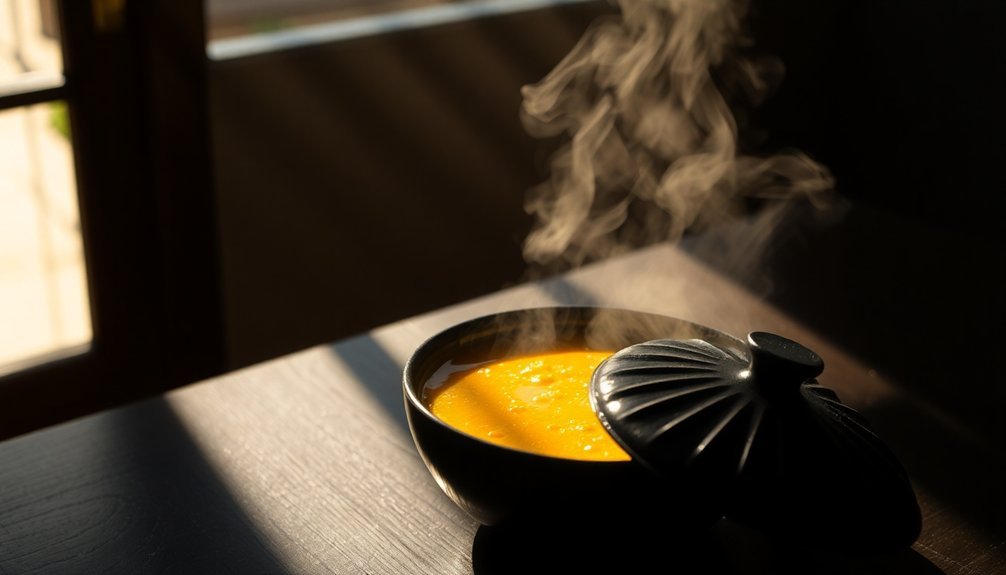
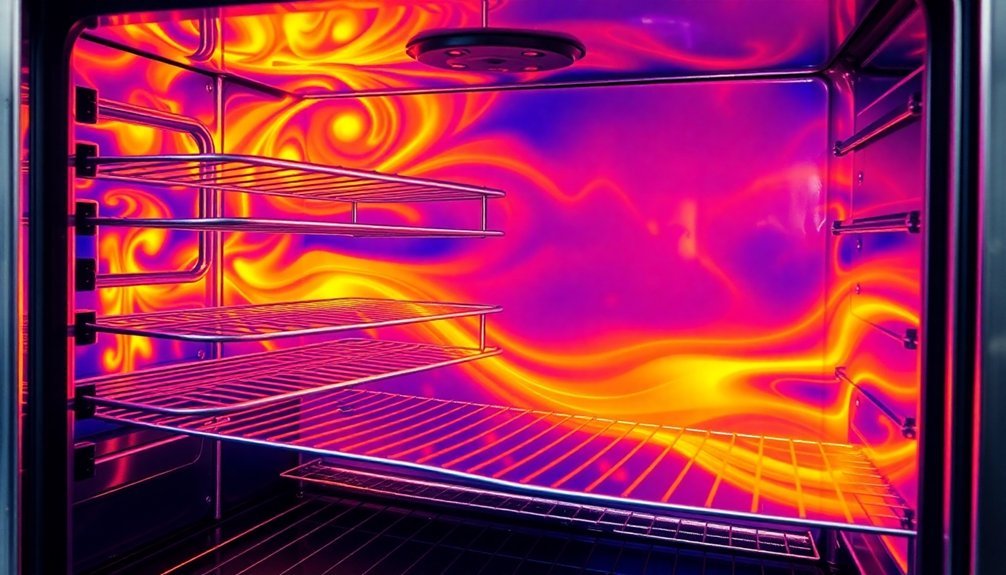
Leave a Reply